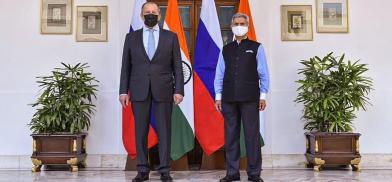Russia holds the key to India’s Eurasian policy
India is one of the few powers that sit at crossroads of Continental Eurasia and the Indo-Pacific --- the two regions that will define this century and to which India's development and security are inextricably linked, writes Lt. Gen. (Dr) Yash Malhotra (retd) for South Asia Monitor

A recent op-ed piece in the Washington Post (13 March 2021), written jointly by the Quad leaders, President Joe Biden of the US, Prime Ministers Narendra Modi, Scott Morrison and Yashihide Suga of India, Australia and Japan respectively, morphs the Quadrilateral Security Dialogue (QSD or the Quad) to a "Quad Framework" hailed by Modi as a "force for global good".
It inter alia includes climate change, critical and new technologies, and handling of Covid-19 pandemic, while remaining committed to: "…. a shared vision for an Indo-Pacific Region that is free, open, resilient and inclusive. ….striving to ensure that the Indo-Pacific is accessible and dynamic, governed by international law and bedrock principles such as freedom of navigation and peaceful resolution of disputes and that all countries are able to make their own political choices, free from coercion."
No matter how you phrase them, Indo-Pacific and the Quad remain maritime ideas. There is no gainsaying that they couch an unflinching desire to checkmate China. For India, when talking of China, their presence in the Indian Ocean Region (IOR) is a bother, but what irks more, is the land border dispute along India's northern borders, accentuated by China's recent aggression.
With China, their "all-weather ally" Pakistan figures in, bringing Sir Creek, Pakistan Occupied Kashmir (POK) and the illegally ceded portion of POK to China for the China-Pakistan Economic Corridor (CPEC), part of China's Belt Road Initiative (BRI) to the forefront. It’s a case of two adversaries trying to keep India confined to the IOR or the proverbial 'South Asia Box'.
When talking of the Indo-Pacific, one cannot help seeing this continental or land border aspect. In the larger Sino-India strategic context, Indo-Pacific, and in it the Quad, therefore appears to be only half ideas!
Belt Road Initiative
Against this, it becomes important to look at the BRI a little closely. BRI has the economic belt notionally running through the heart of Eurasia, while the maritime 'road' sails through the Indo-Pacific, notably the IOR, calling it Indo-Pacific with Chinese characteristics. Actually, the IOR is just one part and subsumed under BRI.
As a policy, BRI takes care of both the continental or land and the maritime or sea aspects; it is indeed dual-use!’ Similarly, while addressing Eastern Ladakh and the Northern Borders, India cannot afford to ignore IOR or for that matter the Indo-Pacific. Needless to say, the reverse would also be true.
Eurasia and Indo-Pacific
Some observers note that Eurasia is the intersection of two continental spaces---Europe and Asia. Russia is the archetypal Eurasian power balanced by NATO. As in the Indo-Pacific, this region too is now witnessing China inching westwards, displacing Russia, riding the BRI façade and attempting to reorder the world both in Europe and the Western Pacific.
India, as some thinkers note, is one of the few powers that sit at crossroads of Continental Eurasia and the Indo-Pacific --- the two regions that will define this century and to which India's development and security are inextricably linked. Both will therefore have to be addressed effectively!
Even as Delhi partners with Washington for the Indo-Pacific (notwithstanding the recent 'freedom of navigation' impropriety by the US 7th Fleet off Lakshadweep), Russia cannot be ignored. Russia is no longer the feeble 'Post-Soviet Union Dissolution' country. It has rebuilt much of its military power and is confident enough to use it for geopolitical leverage.
The balance of power in the Indo-Pacific region is therefore far from binary, with the only major actors being the US and China. Russia is right there too! India has to take note. The Russia-China cooperation in the Pacific is indeed noteworthy, even though some call it an 'Axis of Convenience'. But so is Russia's policy of development of friendly relations with India in the Indian Ocean backed by time-tested 'special and privileged partnership' between Russia and India through thick and thin. So the question arises will Russia side with India?
Russia's geostrategy
During a recent interview to an Indian correspondent about his country's changed relationship with China, Sergei Karagnov, economic and foreign policy adviser to President Vladimir Putin, was asked "The India-China relationship is fraught with tension. What if Russia is asked to make a choice?"
He replied: "…. If you need help from Russia as an intermediary, we could help. But we will not take sides. We will not jeopardize Russian interests for either China or India". To another provocative question, Karagnov said: "Some would say Russia is almost a younger sibling to China".
"We are quasi allies right now, because the United States has chosen to contain both Russia and China……. We also have a lot of common interests. Russia cannot be a junior brother to anybody and has never been so – from the heirs of Genghis Khan to Napoleon and Hitler, we have defeated them all."
So much for the hyped China-Russia cooperation in the Pacific or acceptance of the silent westward push by China in Eurasia!
On the other hand, being a strategic US partner, it becomes essential for India to understand that there are two lines of divisions which the US has to contend with - one in Europe, between Russia and NATO/EU over the latter’s eastward enlargement, Ukraine, European missile-defense programme; and the other in Western Pacific, between China and the USA (along with its Asian allies).
Tightrope walk for India
It must not be forgotten that while the South China Sea and Western Pacific are important, the Indian Ocean remains fundamental for India. India therefore must analyze the answer to this grave question at every stage: Does the US have adequate resources and political will to back India in the IOR or other areas including its northern borders in case the situation demands?
Not only because of India's partnership with Washington in the Indo-Pacific, its 'special and privileged partnership' with Russia also takes a hit in Eurasia due to key differences in perception with the US on assessment of security matrix in the region, especially in the context of India’s relations with Iran and Russia. Additionally, Moscow's partnership with China for connectivity projects in Eurasia and their nexus in the Indo-Pacific muddies the US perception further.
As some say, it indeed is a tightrope walk for India between the political realities of Eurasia and the Indo-Pacific. No doubt in the Indo-Pacific the factors are far more favorable for India, but Eurasia is a different kettle of fish. Like it or not, India's pivot will have to rest on the strength of Russia with who its partnership of late has been under strain. Diplomatic finesse stands underlined to remedy this situation.
Be that as it may, a more robust answer is the need of the hour. For an integrated approach to this challenge to our national security--- continental and maritime - Russia indeed appears to hold the key.
(The writer is an Indian Army veteran and a strategic analyst. The views expressed are personal. He can be contacted at yashmal@hotmail.com)









Post a Comment